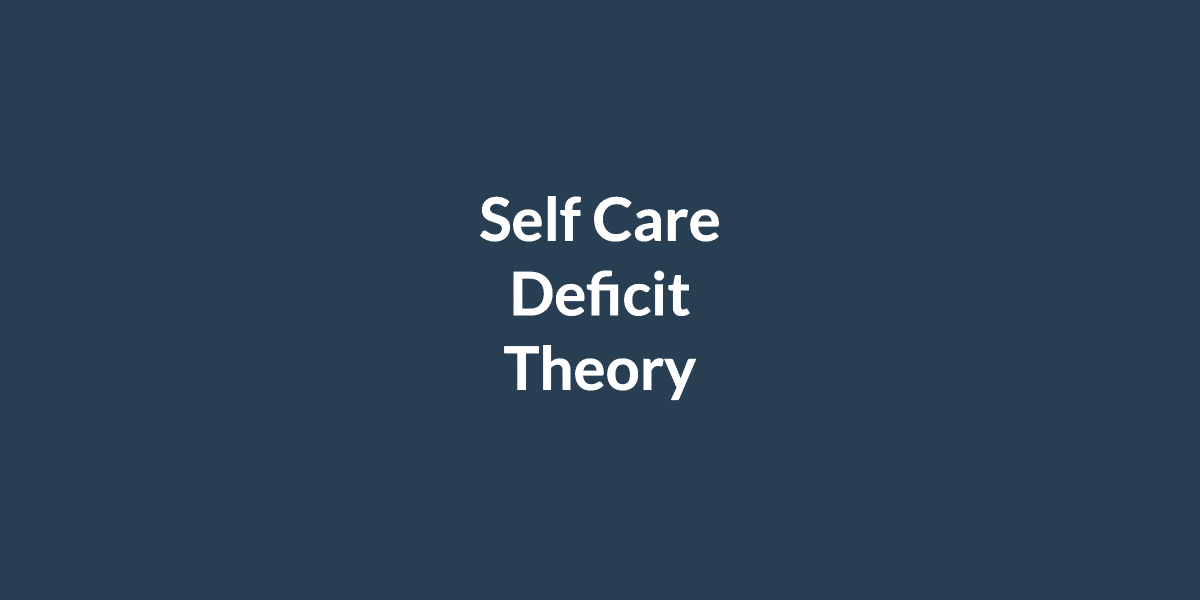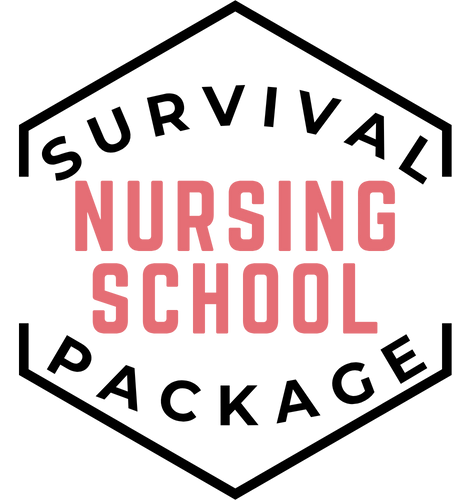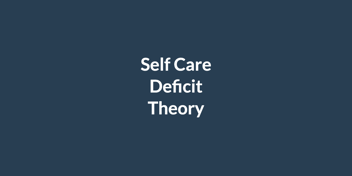Dorothea Orem - Self Care Deficit Theory Explained | NURSING.com

We’ve all been there as new students where you can’t wait for the semester to start… You want to finally figure out what to do with your life and build a solid career…
While this might sound exciting, it can be pretty scary as well. It’s sometimes stressful to think about how you will balance clinical hours with studying for exams…
And all the other responsibilities that come with being a NURSING STUDENT.
Some people put themselves under so much pressure they start feeling guilty of even doing anything outside the nursing curriculum.
Don’t worry, though! We’ve been there, done that… and I am here to share some of what I have learned.
With so many nursing theories to choose from, your first semester can be a little overwhelming.
One nursing theory that you need to know is Dorothea Orem’s self-care theory. It will make your nursing career worthwhile.
Who is Dorothea Orem?
As a nurse, you’ll probably come across this name a lot. I certainly have…DOROTHEA ELIZABETH OREM was an American nurse theorist and educator.
Dorothea, born in 1914, pioneered the Self Care Nursing Deficit Theory. She is well known for her preventative approach to inpatient care.
What is Dorothea Orem’s Self Care Theory?
Dorothea Orem’s self-care theory has gone through several stages of development from 1959 and 2011. It states that nursing should only empower individuals to self-care.
It recognizes that everyone has an inborn ability to self-care…
The theory identifies an effective nursing process for patient education that empowers patients to participate and manage their health-related issues.
It is achievable through PLANNED, PROACTIVE SELF-CARE INTERVENTIONS…
Orem recognized that patient-centered educational activities are critical components to promoting self-care practices among clients because they help to empower the patient.
The approach helps both nurse and patient because education can positively affect the outcome of treatment…
The theory assumes that patients can recover faster when they take more responsibility for their health and cultivate self-care. When practicing the approach, patients are encouraged to:
- Self-monitor when the early signs and symptoms of a potential problem arise.
- Self-assess their personal feelings when faced with a health-related task or decision.
- Take responsibility for planning and executing appropriate action to achieve their treatment/prevention/self-care goals.
- Self-evaluate their responses to the challenges faced in daily living, including medication regimen adherence and impact on lifestyle choices.
- Become involved in setting new goals for the management of health-related issues or prevention strategies.
- Acknowledge the importance of PERSONAL RESPONSIBILITY for life choices that affect health status or risk…
Orem’s Self Care Theory Concepts
The significant assumptions of Orem’s self-care theory are that:
- People should be SELF-RELIANT
- They should be responsible for their health care
- Families should empower and take care of each other, especially those who need assistance
- Nursing is a form of action
- Humans are unique individuals
The Self-Care Deficit Theory of Nursing comprises three interlinked theories. These are:
- The theory of self-care
- The self-care deficit theory
- The theory of nursing systems
Although OREM’S SELF-CARE THEORY consists of general concepts, they cover all nursing areas.
The assumptions of Orem’s self-care theory further depict that to stay functional and alive; humans have the inherent need to communicate and connect with others.
The Theory of Self Care
The theory focuses on activities or behaviors that individuals do to meet their needs in a given situation.
They are actions that people take or omit, even when faced with complex or challenging circumstances. The self-care theory depicts the five dimensions of self-care:
- Self-care is a dynamic interaction between an individual and their environment to maintain health and recover from illness or injury.
- SELF-CARE is a continuum of activities that range from doing nothing to total self-care.
- Human beings are unique in their needs, thoughts, and actions.
- People act on their behalf for purposes of sustaining life or preventing illness or injury.
- People act with others to enhance health outcomes.
Self-Care Requisites
Self-care requirements are actions and behaviors that individuals and families take for their physical, mental, spiritual, interpersonal, environmental, and occupational needs.
The requirements are further categorized into:
Universal Self Care Requisites
UNIVERSAL SELF-CARE requirements are actions and behaviors common to all people, regardless of age group, health status, culture, or environmental factors. They include:
- Sufficient air water, and food intake
- Maintaining an excellent balance between rest and activity
- Provision of care associated with body waste elimination
- Providing a balance between social activities and solitude
- Sufficient sleep
- Provision of safety from physical, emotional, and financial harm…
Health deviation self-care requisites
HEALTH DEVIATION SELF-CARE REQUISITES come into play when an individual, family, or community experiences a health-related episode that mandates changes in usual activities.
These requisites are also considered negative deviations because they indicate that the individual’s status is less than optimal.
These requirements include:
- Emergency first aid measures
- Precautions specific to an illness or injury
- Maintaining sterile conditions for those at risk of infection
- Using medications as prescribed to minimize the effects of a disease or injury
- Initiating a plan that allows for continuity of care
- Accepting one’s current health condition to pave the way for the required medical intervention
Community Self-Care Requisites
Self-care requisites specific to a community are derived from the exact basic universal and health deviation requirements.
However, community self-care requisites are not necessarily activated as a result of health-related emergencies or deviations from usual expected activities. These include:
- Individuals and families’ contributions to the community
- Group strategies that ensure safety within a community
- Interpersonal interactions between members of a community
The Theory of Self Care Deficit
This theory states that NURSING IS THE SCIENCE of caring for people with health problems. The practice of nursing involves tending to clients’ perceived unmet needs related to self-care.
These activities may cause people difficulties or challenges in their daily lives, but they would like to overcome or manage.
It also focuses on factors preventing people from accomplishing tasks themselves, including the absence of appropriate resources, knowledge, or skills.
When these needs are not met, it can result in a deficit that potentially affects health status and outcomes. The five methods of helping include:
- Doing activities for others
- Offering others support
- Guiding
- Teaching
- Offering a conducive environment for personal development
The theory postulates that humans have an innate natural drive for dependency but can be lost due to particular circumstances. These circumstances may include:
- Unbalanced energy exchanges with the environment
- Stimulus deficiency
- Marginalization
Orem believed that humans have a natural desire to be cared for. Despite the innate drive towards dependency, human needs are not only physical but sociocultural as well.
The Theory of Nursing Systems
This theory focuses on how nursing systems interact with individuals to meet their self-care needs. The major components of this theory are:
Wholly Compensatory Nursing System
When individuals cannot engage in self-care activities that require self-directed and controlled ambulation and manipulative movements, they might require wholly compensatory nursing system care.
You’ll find that such persons have limitations that force them to depend on others for continued well-being and even existence socially. Examples are
- Newborns
- Those recovering from major surgery or a post-anesthesia care unit
- Critically ill patients
- Those with severe mental and physical disabilities
Partial Compensatory Nursing System
In a partial compensatory nursing system, either the patient or the nurse can perform significant roles in health care measures.
It means that the individual does not 100% rely on nursing care or other individuals for their well-being. Examples of the partial compensatory nursing system include:
- A nurse assisting a patient walk
- Bringing the food tray to the patient
- Assisting an elderly patient dress after bathing independently
Supportive Educative System
A SUPPORTIVE EDUCATION SYSTEM empowers the individual to perform tasks specific to their current condition or needs.
It is also known as a supportive developmental system where a person learns the necessary externally and internally oriented self-care measures that they cannot plan independently. Examples are
- A nurse teaching a new mother how to breastfeed a newborn
- Counseling a psychiatric patient
- Instilling in a patient better coping mechanisms after an emotional trauma
To effectively carry out the theory of the nursing system, the nursing process determines the self-care deficit. It establishes the roles of the nurses and patients, enabling them to meet self-care demands. The steps include
Assessment
During this stage, it’s established why nursing care is needed. It entails diagnosis and prescription then judgment regarding a suitable care plan. Data collection takes place to develop:
- The patient health status
- The doctor perception of the findings
- The patient’s perspective on the findings
- Health goals considering lifestyle, health status, and life history
- The patient’s requisite self-care plan
- The patient’s ability to perform self-care
Nursing Diagnosis and Care Plans
Here the nurse develops a system that is data-driven and determines whether to opt for partial, wholly compensatory, or supportive educative.
The design considers the data collected in the assessment stage and combines different methods to achieve or overcome the patient’s self-care deficits.
Implementation and Evaluation
The nurse assists in self-care and identifies the results. The collected evidence enables experts to evaluate the achieved results against the expected or specified results.
The usefulness of the Self-Care Theory
Dorothea emphasized the need to cultivate relations between individuals rather than centering on one’s needs.
The theory centers on individuals, expert caregivers, and communities. When the three work together, they can help reduce the impact of illness on the individual.
The theory has been well-received because it is simple to use, flexible, and applicable to any case study.
Orem’s self-care categories help in intervention planning. Why is the theory practical?
It Makes It Easier for Physicians to Understand Patient Needs
It enables caregivers and physicians to understand whether the patient has adequate resources to meet self-care demands.
The theory also helps in understanding the degree to which patients are or are not dependent on caregivers.
The information is valuable when planning interventions, especially for patients with complex conditions.
It is Easy to Use
The theory has five self-care categories applied across different illnesses and at various stages of the disease…
For example, during the initial assessment, a patient is categorized into one of the five levels.
This assessment will help determine whether family members have adequate knowledge about self-care needs, which enables them to be involved in providing care.
It Applies to Different Individuals and Situations
The theory has different levels used to assess more complex situations, such as how treatments like chemotherapy and radiation therapy affect the patients’ ability to attend to self-care needs. It can also be used to assess individuals at risk of poor health, like those with risk factors such as damp living conditions, drug abuse, and financial problems.
The categories help determine the appropriate interventions that will enable these individuals to maintain a healthy lifestyle or overcome illness…
The Theory Cultivates a Relationship Between Nurses and Patients
The theory helps in creating a two-way relationship between the nurse and patient. The categories help identify self-care needs, challenges, and risks related to meeting these needs.
This information enables nurses to provide appropriate interventions during their interactions which improve the quality of care provided.
It Helps Differentiate Between Psychosocial Needs and Physical Needs
Different individuals have varying priorities when it comes to meeting self-care needs. For example, an individual may prioritize attending church over receiving medication.
The theory helps determine whether psychosocial or physical factors limit the patient’s ability to engage in self-care activities.
The Theory is Illness Oriented
Orem’s self-care theory encourages patients, regardless of their health limitations, to be more independent and mindful of how they can manage their self-care needs.
This theory improves patients’ quality of life and encourages them to play a part in managing their health.
Additionally, it enables caregivers to understand what factors limit or allow individuals to take care of themselves.
The information enables them to develop appropriate interventions.
Examples of Orem’s Self Care Theory
Orem’s self-care theory can be applied to various illnesses, as it is based on self-care needs. It defines the roles of nurse practitioners and describes their role in TREATMENT, PREVENTION, AND CARE… The following are some examples of the theory’s application in various clinical cases:
Caring for the Elderly
Nurses are in a position of influence when caring for the elderly.
This care requires nurses to have in-depth knowledge of how different situations affect the patient’s ability to care for themselves.
For example, factors such as memory loss and fatigue due to conditions like dementia make it challenging for patients to undertake activities of daily living…
The theory enables nurses and physicians to plan interventions that will improve the ability of elderly patients to maintain their independence.
Self-Caring Women with Breast Cancer
This case study outlines how the theory monitors patient progress and determines whether care settings are appropriate for individuals who are still recovering from breast cancer surgery.
Diabetes Mellitus Management
In this case study, the theory determines what self-care needs a person with diabetes requires. It helps nurses provide appropriate care and prevent complications from developing.
Cancer Prevention
The theory can also be used to help patients prevent or overcome illness by managing their health better.
It can promote healthy lifestyles among different population groups to prevent illness.
Acute Care Patients
In such scenarios, the nurse has to establish self-care deficits and plan appropriate interventions…
For instance, if an injury causes a person to lose mobility, the nurse can recommend exercises to improve the person’s daily functioning.
Orem’s Self Care Theory in Clinical Decision Making
Orem’s self-care theory is widely used by nurses when making clinical decisions.
It helps nurses understand their patients’ health limitations and plan appropriate interventions that will help meet enduring self-care needs.
It also includes values and beliefs that patients hold, which can help nurses understand their priorities when it comes to self-care.
Through these examples, it’s clear that the nurse’s role is reactive rather than proactive. When the theory is successfully in place, nurses are not overwhelmed with work.
However, it’s not meant to be a tool to reduce the nurse’s role. Instead, it gives them guidance on what needs to be done next.
The benefits to the patient are many. They include:
- The patient will be able to manage their health independently
- Reduction in healthcare costs
- Improved quality of life for the individual, which results in enhanced physical and emotional well-being
- Ability to handle common healthcare problems successfully without the need for professional medical aid
Orem’s self-care theory is a simple but effective way of planning interventions for individuals with varying needs.
It helps nurses understand what health-related self-care issues each patient faces, enabling them to develop appropriate interventions that will meet the patients’ needs.
It enables patients to be more self-reliant, in control, and confident. When patients take an active role in their healthcare, they improve health, happiness, and productivity.
I understand that trying to wrap your head around different nursing theories is overwhelming and confusing. However, taking time to understand Orem’s Self Care theory fully will make your career more fulfilling….
Don’t let anyone talk you into learning all the theories simultaneously. You might end up wasting a lot of time and nothing to show for all your input at the end of it all.






